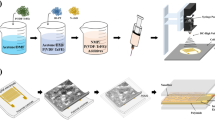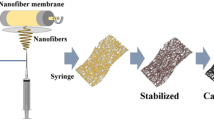Abstract
To realize a conductive substrate with heat resistance and flexibility for the application to flexible electronics, we aimed to reduce the resistance of the fluorine-doped tin oxide (FTO) ceramic nanofiber (NF) non-woven fabrics produced by the electrospinning method. Using NH4F and SnF2 as the raw materials for fluorine doping, the structure and electrical properties of FTO-NF non-woven fabric were compared. The non-woven fabrics obtained in both solutions were several cm square made by NFs with a diameter of 150~800 nm, and all NFs consisted of nanoparticles with a diameter of about 20 nm. The resistivity of the FTO-NF fabric could be reduced to \(5.19 ~\mathrm{\Omega \cdot cm}\) by the improvements such as adding tin isopropoxide and mixing without using water for a solvent without making a precursor of FTO so that the raw material is uniformly adsorbed on the polymer in the solution. By considering the space occupancy of the NFs in the fabric, the minimum net resistivity of the FTO-NF fabric was estimated to be \(0.56 ~ \mathrm{\Omega \cdot cm}\). Since the obtained FTO fabric was brittle and cracked when bent, we made a prototype of a three-layer NF non-woven fabric composited with amorphous SiO2 NFs. The sheet resistance was \(6.4 ~\mathrm{k\Omega /sq}\), no cracks or breaks occurred even when wrapped around a glass rod with a diameter of 5 mm\(\phi\), and the rate of increase in the resistance after 100 bends could be suppressed to 4.9%.












Similar content being viewed by others
References
C. Fernandes, A. Santa, A. Santos, P. Bahubalindruni, J. Deuermeier, R. Martins, E. Fortunato, P. Barquinha, Adv. Electron. Mater. 4, 1800032 (2018)
B.C. Jang, Y. Nam, B.J. Koo, J. Choi, S.G. Im, S.K. Park, S. Choi, Adv. Funct. Mater. 28, 1704725 (2018)
J. Kim, H.J. Shim, J. Yang, M.K. Choi, D.C. Kim, J. Kim, T. Hyeon, D. Kim, Adv. Mater. 29, 1700217 (2017)
J.H. Park, H.E. Lee, C.K. Jeong, D.H. Kim, S.K. Hong, K. Park, L.J. Lee, Nano Energy 56, 531–546 (2019)
X. Wang, M. Xi, H. Fong, Z. Zhu, A.C.S. Appl, Mater. Interfaces 6, 15925–15932 (2014)
J.H. Wendorff, S. Agarwal, A. Greiner, Electrospinning, Materials, Processing, and Applications (Wiley, Hoboken, 2012)
M.M. Munir, F. Iskandar, K.M. Yun, K. Okuyama, M. Abdullah, Nanotechnology 19, 145603 (2008)
F. Iskandar, A.B. Suryamas, M. Kawabe, M.M. Munir, K. Okuyama, T. Tarao, T. Nishitani, J. Appl. Phys. 49, 010213 (2010)
M. Shahhosseininiaa, S. Bazgirb, M. DaliriJouparic, Math. Sci. Eng. 91, 502 (2018)
D. Li, Y. Xia, Nano Lett. 3, 555–560 (2003)
M.M. Munir, H. Widiyandari, F. Iskandar, K. Okuyama, Nanotechnology 19, 375601 (2008)
B. O’Regan, M. Grätzel, Nature 353, 737 (1991)
Y. Horie, T. Watanabe, M. Deguchi, D. Asakura, T. Nomiyama, Electrochim. Acta 105, 394 (2013)
S. Guo, Y. Horie, S. Imada, M.Z. Bin Mukhlish, T. Nomiyama, J. Mater. Sci. 28, 13084 (2017)
M.Z. Bin Mukhlish, Y. Horie, K. Higashi, A. Ichigi, S. Guo, T. Nomiyama, Ceram. Int. 43, 8146 (2017)
M.J. Alam, D.C. Cameron, Thin Solid Films 420–421, 76 (2002)
A. Moholkar, S. Pawar, K. Rajpure, C. Bhosale, J. Kim, Appl. Surf. Sci. 255, 9358 (2009)
B. Wang, A. Thukral, Z. Xie, L. Liu, X. Zhang, W. Huang, X. Yu, C. Yu, T.J. Marks, A. Facchetti, Nat. Commun. 11, 2405 (2020). https://doi.org/10.1038/s41467-020-16268-8
M. Xi, X. Wang, Y. Zhao, Z. Zhu, H. Fong, Appl. Phys. Lett. 104, 133102 (2014)
A. Kumara, K. Ranasinghe, N. Jayaweera, N. Bandara, M. Okuya, G. Rajapakse, J. Phys. Chem. C 118, 16479 (2014)
S. Chen, H. Du, Y. Wei, L. Peng, Y. Li, L. Gan, F. Kang, Int. J. Electrochem. Sci. 12, 6221 (2017)
X. Xia, X.J. Dong, Q.F. Wei, Y.B. Cai, K.Y. Lu, Polym. Lett. 6, 169 (2012)
Z. Banyamin, P. Kelly, G. West, J. Boardman, Coatings 4, 732 (2014)
Acknowledgements
This work was supported by JSPS KAKENHI Grant Numbers 23360042, 16K04901, and 20K05344.
Author information
Authors and Affiliations
Corresponding author
Additional information
Publisher's Note
Springer Nature remains neutral with regard to jurisdictional claims in published maps and institutional affiliations.
Rights and permissions
About this article
Cite this article
Yoshinaga, K., Horie, Y., Ichigi, A. et al. Conductive self-standing nanofiber fabric of fluorine-doped tin oxide prepared by electrospinning for use in flexible electronics. J Mater Sci: Mater Electron 32, 11823–11834 (2021). https://doi.org/10.1007/s10854-021-05812-x
Received:
Accepted:
Published:
Issue Date:
DOI: https://doi.org/10.1007/s10854-021-05812-x




